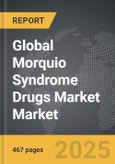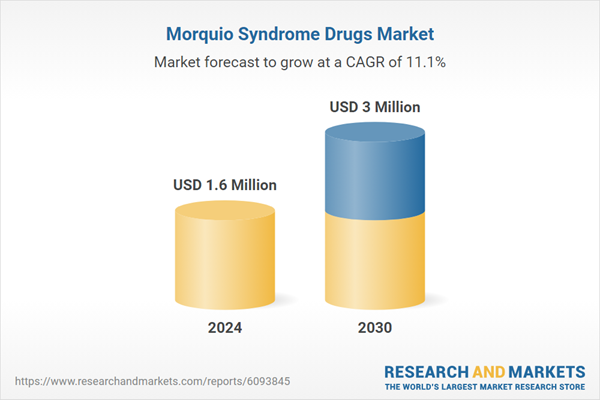Global Morquio Syndrome Drugs Market - Key Trends & Drivers Summarized
What Is Morquio Syndrome and Why Are Targeted Therapies Critical?
Morquio syndrome, also known as Mucopolysaccharidosis type IV (MPS IV), is a rare autosomal recessive lysosomal storage disorder caused by deficiencies in the GALNS or GLB1 enzymes. This results in the accumulation of glycosaminoglycans (GAGs) in the body, leading to severe skeletal abnormalities, joint dysfunction, vision and hearing impairment, and cardiopulmonary complications. Given the progressive nature and multisystem impact of the disease, drug treatment focuses on enzyme replacement therapy (ERT) and supportive care aimed at slowing progression and managing symptoms.The ultra-rare status of Morquio syndrome has made it a key focus of orphan drug development efforts. ERT - particularly with elosulfase alfa - has emerged as the primary treatment to address the underlying enzyme deficiency in MPS IV-A. While it does not reverse existing skeletal damage, ERT improves endurance, reduces GAG accumulation, and may enhance respiratory and cardiovascular function over time. In the absence of curative options, timely diagnosis and consistent therapy are essential to prolong mobility and improve quality of life.
What Innovations Are Advancing Therapeutic Efficacy and Access?
Current innovations are centered on improving the delivery, bioavailability, and long-term efficacy of enzyme replacement therapies. Researchers are exploring modified enzymes with longer half-lives and enhanced tissue penetration - especially targeting the skeletal system, which remains poorly responsive to conventional ERT due to vascular limitations. Intrathecal administration methods and fusion protein technologies are being investigated to enhance enzyme access to bone and central nervous system tissues.Gene therapy is another area of active research, aiming to introduce functional copies of the GALNS or GLB1 gene using viral vectors. Preclinical studies show promise in achieving systemic enzyme expression with potentially fewer dosing requirements. Additionally, substrate reduction therapy (SRT) and chaperone therapy are being explored as adjunct or alternative approaches. These innovations are being enabled by advancements in molecular diagnostics, patient registries, and clinical trial infrastructure for rare diseases.
Which Patient Populations and Geographies Are Driving Demand for Treatment?
Pediatric patients make up the majority of Morquio syndrome cases, with diagnosis typically occurring between ages two and six. Early treatment initiation is associated with better outcomes, particularly in maintaining mobility and slowing cardiopulmonary decline. Demand is most concentrated in North America and Europe, where newborn screening programs, access to genetic testing, and availability of orphan drug reimbursement frameworks support treatment initiation.In Latin America, the Middle East, and parts of Asia-Pacific, underdiagnosis remains a challenge due to limited awareness and diagnostic infrastructure. However, advocacy groups and international collaborations are increasing patient identification and access to therapies in these regions. The increasing availability of genetic testing and biomarker-based diagnosis is helping identify more patients at earlier stages, driving long-term demand for therapies and supportive care.
The Growth in the Morquio Syndrome Drugs Market Is Driven by Several Factors…
The growth in the Morquio syndrome drugs market is driven by several factors including rising awareness of rare lysosomal storage diseases, improvements in early diagnostic methods, and ongoing innovation in enzyme and gene therapies. Market expansion is supported by orphan drug incentives, favorable regulatory frameworks, and increasing inclusion of Morquio therapies in national rare disease programs. Advances in biomarker monitoring, drug delivery technologies, and real-world data collection are improving clinical outcomes and expanding patient reach. As healthcare systems prioritize earlier intervention and long-term disease management for ultra-rare disorders, demand for novel and more effective Morquio syndrome therapies continues to rise globally.Report Scope
The report analyzes the Morquio Syndrome Drugs market, presented in terms of market value (US$). The analysis covers the key segments and geographic regions outlined below:- Segments: Treatment (Enzyme Replacement Therapy, Hematopoietic Stem Cell Therapy, Gene Therapy, Other Treatments); Disease Type (Morquio A, Morquio B); Form (Solid Form, Liquid Form); Distribution Channel (Hospital Pharmacies, Online Pharmacies, Retail Pharmacies).
- Geographic Regions/Countries: World; United States; Canada; Japan; China; Europe (France; Germany; Italy; United Kingdom; Spain; Russia; and Rest of Europe); Asia-Pacific (Australia; India; South Korea; and Rest of Asia-Pacific); Latin America (Argentina; Brazil; Mexico; and Rest of Latin America); Middle East (Iran; Israel; Saudi Arabia; United Arab Emirates; and Rest of Middle East); and Africa.
Key Insights:
- Market Growth: Understand the significant growth trajectory of the Enzyme Replacement Therapy segment, which is expected to reach US$1.5 Million by 2030 with a CAGR of a 9.3%. The Hematopoietic Stem Cell Therapy segment is also set to grow at 13.5% CAGR over the analysis period.
- Regional Analysis: Gain insights into the U.S. market, valued at $436 Thousand in 2024, and China, forecasted to grow at an impressive 14.8% CAGR to reach $613.8 Thousand by 2030. Discover growth trends in other key regions, including Japan, Canada, Germany, and the Asia-Pacific.
Why You Should Buy This Report:
- Detailed Market Analysis: Access a thorough analysis of the Global Morquio Syndrome Drugs Market, covering all major geographic regions and market segments.
- Competitive Insights: Get an overview of the competitive landscape, including the market presence of major players across different geographies.
- Future Trends and Drivers: Understand the key trends and drivers shaping the future of the Global Morquio Syndrome Drugs Market.
- Actionable Insights: Benefit from actionable insights that can help you identify new revenue opportunities and make strategic business decisions.
Key Questions Answered:
- How is the Global Morquio Syndrome Drugs Market expected to evolve by 2030?
- What are the main drivers and restraints affecting the market?
- Which market segments will grow the most over the forecast period?
- How will market shares for different regions and segments change by 2030?
- Who are the leading players in the market, and what are their prospects?
Report Features:
- Comprehensive Market Data: Independent analysis of annual sales and market forecasts in US$ Million from 2024 to 2030.
- In-Depth Regional Analysis: Detailed insights into key markets, including the U.S., China, Japan, Canada, Europe, Asia-Pacific, Latin America, Middle East, and Africa.
- Company Profiles: Coverage of players such as Ande Monofilament, Berkley Fishing (Pure Fishing), Calamus, Daiwa (Globeride, Inc.), Gosen Co., Ltd. and more.
- Complimentary Updates: Receive free report updates for one year to keep you informed of the latest market developments.
Some of the 41 companies featured in this Morquio Syndrome Drugs market report include:
- Abeona Therapeutics Inc.
- Alexion Pharmaceuticals Inc.
- Amgen Inc.
- ArmaGen
- BioMarin Pharmaceutical Inc.
- Concert Pharmaceuticals Inc.
- Genzyme Corporation
- GREEN CROSS Corporation
- JCR Pharmaceuticals Co., Ltd.
- Novartis AG
- Novo Nordisk A/S
- Pfizer Inc.
- Regenxbio Inc.
- Sangamo Therapeutics
- Sanofi
- Shire plc
- Takeda Pharmaceutical Company Limited
- Ultragenyx Pharmaceutical Inc.
- Vtesse Inc.
- Zymenex A/S
This edition integrates the latest global trade and economic shifts into comprehensive market analysis. Key updates include:
- Tariff and Trade Impact: Insights into global tariff negotiations across 180+ countries, with analysis of supply chain turbulence, sourcing disruptions, and geographic realignment. Special focus on 2025 as a pivotal year for trade tensions, including updated perspectives on the Trump-era tariffs.
- Adjusted Forecasts and Analytics: Revised global and regional market forecasts through 2030, incorporating tariff effects, economic uncertainty, and structural changes in globalization. Includes historical analysis from 2015 to 2023.
- Strategic Market Dynamics: Evaluation of revised market prospects, regional outlooks, and key economic indicators such as population and urbanization trends.
- Innovation & Technology Trends: Latest developments in product and process innovation, emerging technologies, and key industry drivers shaping the competitive landscape.
- Competitive Intelligence: Updated global market share estimates for 2025, competitive positioning of major players (Strong/Active/Niche/Trivial), and refined focus on leading global brands and core players.
- Expert Insight & Commentary: Strategic analysis from economists, trade experts, and domain specialists to contextualize market shifts and identify emerging opportunities.
Table of Contents
Companies Mentioned (Partial List)
A selection of companies mentioned in this report includes, but is not limited to:
- Abeona Therapeutics Inc.
- Alexion Pharmaceuticals Inc.
- Amgen Inc.
- ArmaGen
- BioMarin Pharmaceutical Inc.
- Concert Pharmaceuticals Inc.
- Genzyme Corporation
- GREEN CROSS Corporation
- JCR Pharmaceuticals Co., Ltd.
- Novartis AG
- Novo Nordisk A/S
- Pfizer Inc.
- Regenxbio Inc.
- Sangamo Therapeutics
- Sanofi
- Shire plc
- Takeda Pharmaceutical Company Limited
- Ultragenyx Pharmaceutical Inc.
- Vtesse Inc.
- Zymenex A/S
Table Information
| Report Attribute | Details |
|---|---|
| No. of Pages | 467 |
| Published | November 2025 |
| Forecast Period | 2024 - 2030 |
| Estimated Market Value ( USD | $ 1.6 Million |
| Forecasted Market Value ( USD | $ 3 Million |
| Compound Annual Growth Rate | 11.1% |
| Regions Covered | Global |









